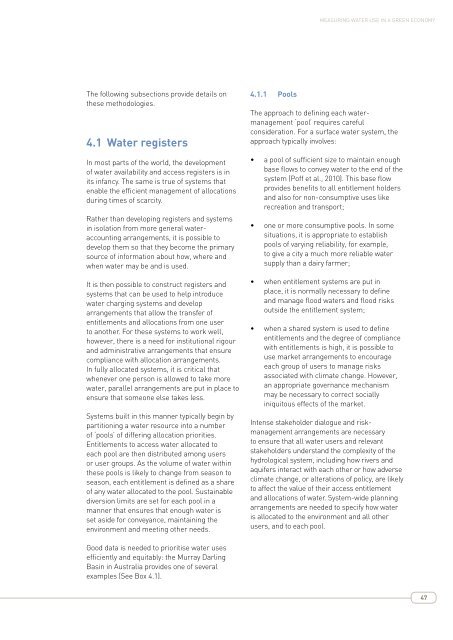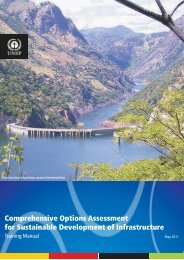MEASURING WATER USE IN A GREEN ECONOMY - UNEP
MEASURING WATER USE IN A GREEN ECONOMY - UNEP
MEASURING WATER USE IN A GREEN ECONOMY - UNEP
You also want an ePaper? Increase the reach of your titles
YUMPU automatically turns print PDFs into web optimized ePapers that Google loves.
Measuring water use in a green economy<br />
The following subsections provide details on<br />
these methodologies.<br />
4.1 Water registers<br />
In most parts of the world, the development<br />
of water availability and access registers is in<br />
its infancy. The same is true of systems that<br />
enable the efficient management of allocations<br />
during times of scarcity.<br />
Rather than developing registers and systems<br />
in isolation from more general wateraccounting<br />
arrangements, it is possible to<br />
develop them so that they become the primary<br />
source of information about how, where and<br />
when water may be and is used.<br />
It is then possible to construct registers and<br />
systems that can be used to help introduce<br />
water charging systems and develop<br />
arrangements that allow the transfer of<br />
entitlements and allocations from one user<br />
to another. For these systems to work well,<br />
however, there is a need for institutional rigour<br />
and administrative arrangements that ensure<br />
compliance with allocation arrangements.<br />
In fully allocated systems, it is critical that<br />
whenever one person is allowed to take more<br />
water, parallel arrangements are put in place to<br />
ensure that someone else takes less.<br />
Systems built in this manner typically begin by<br />
partitioning a water resource into a number<br />
of ‘pools’ of differing allocation priorities.<br />
Entitlements to access water allocated to<br />
each pool are then distributed among users<br />
or user groups. As the volume of water within<br />
these pools is likely to change from season to<br />
season, each entitlement is defined as a share<br />
of any water allocated to the pool. Sustainable<br />
diversion limits are set for each pool in a<br />
manner that ensures that enough water is<br />
set aside for conveyance, maintaining the<br />
environment and meeting other needs.<br />
4.1.1 Pools<br />
The approach to defining each watermanagement<br />
‘pool’ requires careful<br />
consideration. For a surface water system, the<br />
approach typically involves:<br />
• a pool of sufficient size to maintain enough<br />
base flows to convey water to the end of the<br />
system (Poff et al., 2010). This base flow<br />
provides benefits to all entitlement holders<br />
and also for non-consumptive uses like<br />
recreation and transport;<br />
• one or more consumptive pools. In some<br />
situations, it is appropriate to establish<br />
pools of varying reliability, for example,<br />
to give a city a much more reliable water<br />
supply than a dairy farmer;<br />
• when entitlement systems are put in<br />
place, it is normally necessary to define<br />
and manage flood waters and flood risks<br />
outside the entitlement system;<br />
• when a shared system is used to define<br />
entitlements and the degree of compliance<br />
with entitlements is high, it is possible to<br />
use market arrangements to encourage<br />
each group of users to manage risks<br />
associated with climate change. However,<br />
an appropriate governance mechanism<br />
may be necessary to correct socially<br />
iniquitous effects of the market.<br />
Intense stakeholder dialogue and riskmanagement<br />
arrangements are necessary<br />
to ensure that all water users and relevant<br />
stakeholders understand the complexity of the<br />
hydrological system, including how rivers and<br />
aquifers interact with each other or how adverse<br />
climate change, or alterations of policy, are likely<br />
to affect the value of their access entitlement<br />
and allocations of water. System-wide planning<br />
arrangements are needed to specify how water<br />
is allocated to the environment and all other<br />
users, and to each pool.<br />
Good data is needed to prioritise water uses<br />
efficiently and equitably: the Murray Darling<br />
Basin in Australia provides one of several<br />
examples (See Box 4.1).<br />
47

















